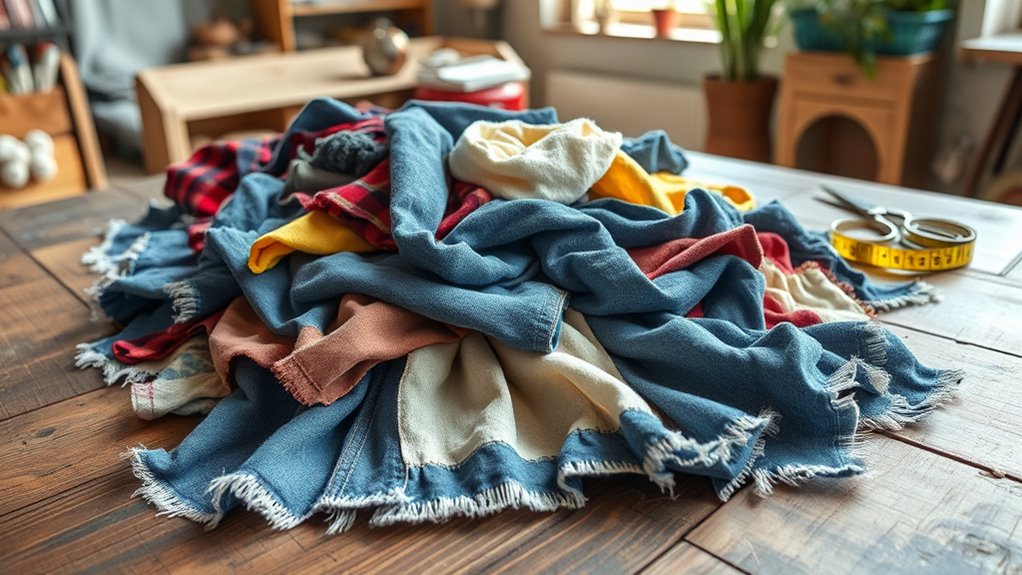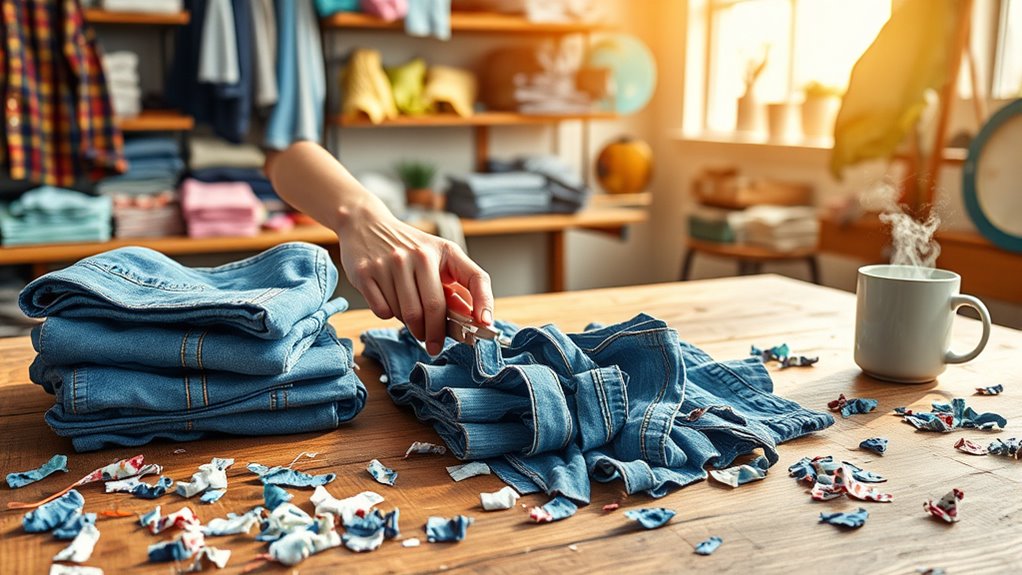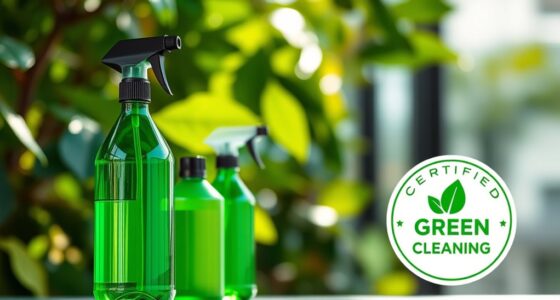To eco-friendly upcycle old clothes into cleaning rags, pick durable fabrics like cotton or linen and cut them into manageable sizes. Avoid delicate or heavily embellished materials. Use shredded paper alongside your fabric rags for extra cleaning power. Wash your rags regularly and store them in a designated spot for easy access. By repurposing items you already own, you reduce waste and support sustainable habits—discover more tips to make the most of your upcycling efforts.
Key Takeaways
- Select durable fabrics like cotton or linen, avoiding delicate or heavily embellished materials.
- Cut clothes into manageable sizes and reinforce edges to prevent fraying during use.
- Incorporate sustainable fabrics such as organic cotton or hemp for eco-friendly cleaning rags.
- Store and wash rags regularly, keeping separate sets for different tasks to maintain hygiene.
- Combine shredded paper with fabric rags for enhanced cleaning and waste reduction.

Turning old clothes into cleaning rags is a practical way to reduce waste and save money. Instead of tossing out worn-out shirts or pants, you can transform them into useful, eco-friendly cleaning tools. This approach not only minimizes clutter but also supports sustainable habits by repurposing items you already own. When selecting clothes to upcycle, look for fabrics that are durable and absorbent, such as cotton or linen, which are great for cleaning tasks. Avoid delicate or heavily embellished fabrics, as they may not hold up well to repeated washing and use.
One way to make your cleaning rags even more environmentally friendly is by incorporating sustainable fabrics. These materials are often produced with less chemical input and have a smaller carbon footprint. For example, organic cotton or hemp fabrics are excellent choices because they’re renewable and biodegradable. Using sustainable fabrics also aligns with efforts to reduce reliance on synthetic materials that can shed microplastics during cleaning. When repurposing old clothes, you might also consider recycling paper for cleaning purposes, such as using shredded paper for dusting or as a messy but biodegradable substitute for traditional cleaning cloths. Combining recycled paper with fabric rags can enhance your cleaning toolkit while further decreasing waste.
To create your rags, start by cutting your chosen clothes into manageable sizes—square or rectangular shapes are easiest to work with. You don’t need perfect edges; frayed edges can actually increase the fabric’s surface area, making it more effective at trapping dust and dirt. If you want more durable rags, double-layer the fabric or sew a simple hem around the edges to prevent fraying. Keep different rags for specific tasks—some for kitchen spills, others for bathroom cleaning—to maintain hygiene and prevent cross-contamination. Additionally, selecting vetted fabrics ensures your cleaning rags are safe, effective, and free from harmful chemicals.
Storing your upcycled rags in a designated container near your cleaning supplies makes it easy to grab them when needed. Wash them regularly with mild detergent to keep them fresh and free of bacteria. Remember, these rags are reusable, so take pride in maintaining them properly. By upcycling old clothes into cleaning rags, you’re not only giving new life to items that might otherwise be discarded but also contributing to a more sustainable lifestyle. Incorporating recycled paper and sustainable fabrics into your cleaning routine helps you reduce waste, lower your environmental impact, and create a greener home.
Frequently Asked Questions
What Are the Best Fabrics for Cleaning Rags?
When choosing fabrics for cleaning rags, consider fabric softness and durability. Cotton is a top choice because it’s soft and absorbent, making cleaning easy without scratching surfaces. Flannel is also excellent due to its durability and gentle texture. Avoid rough fabrics like burlap, which can scratch surfaces. Focus on fabrics that balance softness with durability, ensuring your rags last through repeated use and cleaning tasks.
How Do I Prevent Mold on Repurposed Rags?
You might worry about mold prevention, but it’s simple to keep your repurposed rags fresh. After washing, make sure to dry them thoroughly in the sun or a well-ventilated area. Store your rags in a dry, airtight container to prevent moisture buildup. Regularly inspect and wash them promptly if they feel damp. Using these storage tips and ensuring proper drying keeps mold at bay and extends your rags’ lifespan.
Can Old Clothes Be Used for Outdoor Cleaning?
Yes, old clothes work well for outdoor cleaning, especially for tasks like garden sprayers or window washing. You can cut them into rags that are absorbent and durable, perfect for wiping down outdoor surfaces or cleaning glass. Just make sure they’re clean and free of any pesticides or chemicals. Using old clothes for outdoor cleaning is eco-friendly and cost-effective, helping you keep your space spotless while repurposing materials you already have.
How Do I Dispose of Old Cleaning Rags Responsibly?
Think of your old cleaning rags as stories that need a proper ending. You should consider textile recycling options, sending them to facilities that turn fabrics into new materials. If they’re contaminated with hazardous waste, never toss them in regular trash. Instead, follow hazardous waste disposal guidelines to keep the environment safe. Responsible disposal guarantees these rags don’t turn into environmental villains but become part of a sustainable cycle.
Are There Safety Tips for Upcycling Delicate Fabrics?
When upcycling delicate fabrics, you should handle the fabric carefully to prevent damage, using gentle fabric handling techniques. Always wash and dry the fabric thoroughly before repurposing, and check for any dye safety issues to avoid skin irritation or color bleeding. Wear gloves if necessary, and test for colorfastness. These safety tips help guarantee your upcycling project is both safe and successful.
Conclusion
So, next time you consider throwing out old clothes, remember you can turn them into useful cleaning rags instead. It’s simple, eco-friendly, and saves money — plus, you don’t have to worry about them falling apart easily. Sure, some might think they won’t work as well as store-bought options, but with a quick cut and wash, your DIY rags will do just fine. Give it a try and make a positive impact today!










